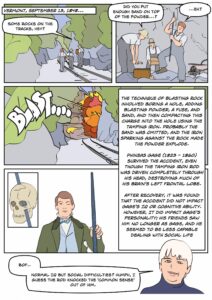

Muddling literally involves a trial and error process of "feeling" our way through a complex ecology to satisfying outcomes. This involves applying our experiences and utilizing domain constraints (e.g., landmarks) in a smart way. However, muddling involves more than just "knowledge' or 'intelligence.' It also involves feelings. It takes passion to persist in the face of inevitable errors. It takes a cool head to face the inevitable risks. It takes discipline to persist when progress is slow. And it takes a well tuned value system to set appropriate goals and to gauge progress toward those goals.
Information processing models of cognition, based on a computer metaphor have tended to consider emotions to be a primitive source of 'noise' that interferes with successful adaptation and performance. In this context, the difficulties that Phinneas Gage had in adjusting to life after his accident have been attributed to damage to an internal executive that normally suppresses more primitive instincts associated with emotions. However, recent research by Damasio suggests that the difficulties that Gage experienced may be due to a lack of emotional constraints - that is, a kind of autism in which the emotions are cut-off from the executive processing, leading to a cold logical process - that is poorly tuned to the realities of everyday life, that lacks the common sense necessary for consistently achieving satisfaction.
Damasio's work suggests that rather than thinking about emotions as 'primitive' instincts that are a threat to satisfactory functioning, it might be better to think about emotions as evolutionarily tuned instincts that help to ground our newer cognitive capabilities in the realities of every day situations. Perhaps, the tuning of emotional and aesthetic sensitivities are fundamental to human expertise. This might be part of why Don Norman's claim that
Beautiful things work better!
is true. Perhaps, expertise ultimately depends on our ability to coordinate our hearts and minds. Perhaps, designing technologies to support human expertise requires developing representations that are both well tuned to the domain constraints and to the aesthetic sensibilities of people. Perhaps, it is the intimate intermingling of the pragmatic with the aesthetic that make Pirsig's construct of Quality so difficult to explain in conventional terms.
Any philosophic explanation of Quality is going to be both false and true precisely because it is a philosophic explanation. The process of philosophic explanation is an analytic process, a process of breaking something down into subjects and predicates. What I mean (and everybody else means) by the word ‘quality’ cannot be broken down into subjects and predicates. This is not because Quality is so mysterious but because Quality is so simple, immediate and direct.
References
Damasio, A. (1994). Descartes’ Error: Emotion, reason, and the human brain. New York: Penguin Books.
Norman, D.A. (2005). Emotional design. New York: Basic Books.
Pirsig, R.M. (1974). Zen and the art of motorcycle maintenance. New York: Perennial Classics. (p. 254).
